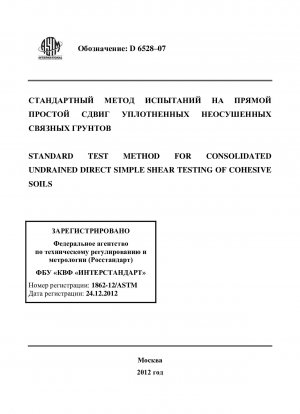ASTM D6528-07
Standard Test Method for Consolidated Undrained Direct Simple Shear Testing of Cohesive Soils
- Standard No.
- ASTM D6528-07
- Release Date
- 2007
- Published By
- American Society for Testing and Materials (ASTM)
- Status
- Replace By
- ASTM D6528-17
- Latest
- ASTM D6528-17
- Scope
The shear strength of a specimen depends on the soil type, normal consolidation stress, time of consolidation, rate of strain, and prior stress history of the soil.
In this test, the shear strength is measured under constant volume conditions that are equivalent to undrained conditions for a saturated specimen; hence, the test is applicable to field conditions wherein soils have fully consolidated under one set of stresses, and then are subjected to changes in stress without time for further drainage to take place.
The constant volume (undrained) strength is a function of stress conditions. In this test method, the strength is measured under plane strain conditions and the principle stresses continuously rotate due to the application of shear stress. This simple shear stress condition occurs in many field situations including zones below a long embankment and around axially loaded piles.
The state of stress within the simple shear specimen is not sufficiently defined nor uniform enough to allow rigorous interpretation of the results. Expressing the data in terms of the shear stress and normal effective stress on the horizontal plane is useful for engineering purposes, but should not be confused with the effective stress parameters derived from other shear tests having better defined states of stress.
The values of the secant shear modulus can be used to estimate the initial settlements of embankments built on saturated cohesive soils due to undrained shear deformations.
The data from the consolidation portion of this test are comparable to results obtained using Test Method D 2435
provided that the more rigorous consolidation procedure of Test Method D 2435 is followed. 5.6.1 The axial displacements measured from Test Method D 2435
are somewhat smaller than for the simple shear test because the specimenrsquo;lateral confinement is less rigid and the top platen is unable to rotate. 5.6.2 The estimated preconsolidation pressure is comparable provided the specimen is loaded sufficiently into the normally consolidated range.
5.6.3 The rate of consolidation is comparable.
1.1 This test method defines equipment specifications and testing procedures for the measurement of constant volume strength and stress-strain characteristics of cohesive soils after one-dimensional consolidation using a constant rate of simple shear deformation mode of loading. The constant volume condition is equivalent to the undrained condition for saturated specimens.
1.2 This test method is written specifically for devices that test rectangular parallelepiped or cylindrical specimens. Other more general devices, such as the torsional shear hollow cylinder, may be used to perform consolidated constant volume simple shear tests but are beyond the scope of this test method.
1.3 This test method is applicable to testing intact, laboratory reconstituted, and compacted soils, however, it does not include specific guidance for reconstituting or compacting test specimens.
1.4 It shall be the responsibility of the agency requesting this test to specify the magnitude of the normal consolidation stress prior to constant volume shear and, when appropriate, the maximum normal consolidation stress, which will result in an overconsolidated specimen.
1.5 All recorded and calculated values shall conform to the guide for significant digits and rounding established in Practice D 6026
. 1.5.1 The procedures used to specify how data are collected/recorded and calculated in this test method are regarded as the industry standard. In addition, they are representative of the significant digits that should generally be retained. The procedures used do not consider material variation......
ASTM D6528-07 Referenced Document
- ASTM D1587 Standard Practice for Thin-Walled Tube Sampling of Soils for Geotechnical Purposes*, 2024-04-19 Update
- ASTM D2216 Standard Test Method for Laboratory Determination of Water (Moisture) Content of Soil and Rock by Mass
- ASTM D2435 Standard Test Method for One-Dimensional Consolidation Properties of Soils
- ASTM D2487 Standard Test Method for Classification Of Soils For Engineering Purposes
- ASTM D2488 Recommended Practice for Description Of Soils (Visual-Manual Procedure)
- ASTM D3550 Standard Practice for Thick Wall, Ring-Lined, Split Barrel, Drive Sampling of Soils
- ASTM D3740 Standard Practice for Minimum Requirements for Agencies Engaged in the Testing and/or Inspection of Soil and Rock as Used in Engineering Design and Construction
- ASTM D422 Standard Test Method for Particle-Size Analysis of Soils
- ASTM D4220 Standard Practices for Preserving and Transporting Soil Samples
- ASTM D4318 Standard Test Methods for Liquid Limit, Plastic Limit, and Plasticity Index of Soils
- ASTM D4452 Standard Test Methods for X-Ray Radiography of Soil Samples
- ASTM D6026 Standard Practice for Using Significant Digits in Geotechnical Data
- ASTM D653 Standard Terminology Relating to Soil, Rock, and Contained Fluids
- ASTM D854 Standard Test Methods for Specific Gravity of Soil Solids by the Water Displacement Method
ASTM D6528-07 history
- 2017 ASTM D6528-17 Standard Test Method for Consolidated Undrained Direct Simple Shear Testing of Fine Grain Soils
- 2007 ASTM D6528-07 Standard Test Method for Consolidated Undrained Direct Simple Shear Testing of Cohesive Soils
- 2000 ASTM D6528-00 Standard Test Method for Consolidated Undrained Direct Simple Shear Testing of Cohesive Soils
